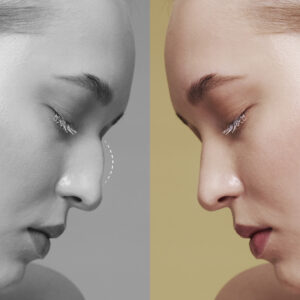Description
Familiarity with treatment
The inner (medial) thigh lift is a surgical procedure aimed at reducing excess skin and fat in the upper portion of the inner thigh, resulting in a firmer and more contoured appearance. Here is an overview of the procedure based on the information provided in the search results:
Procedure Overview: The inner thigh lift, also known as medial thighplasty, is commonly performed to address sagging skin and excess fat in the inner thigh area. It is often chosen by individuals who have experienced weight loss or have concerns about the appearance of their thighs.
Incision Placement: The incision pattern for an inner thigh lift can vary depending on the patient’s needs and the surgeon’s preference. One technique involves placing incisions in the groin area, extending downward and wrapping around the back of the thigh. Another technique removes excess skin from the groin down to the knee using an incision along the inseam.
Skin and Fat Removal: During the procedure, excess skin and fat are removed from the inner thigh area. The underlying tissue may also be reshaped and tightened to achieve a more desirable contour.
Suture and Closure: After the necessary adjustments are made, the remaining skin is lifted and smoothed, and the incision site is sutured closed. The specific suturing technique may vary depending on the surgeon’s preference and the patient’s individual needs.
Combination with Liposuction: In some cases, an inner thigh lift may be combined with liposuction to achieve optimal results. Liposuction can help remove excess fat deposits and further enhance the contour of the thighs.
Recovery and Scarring: Following the procedure, patients will have a recovery period during which they will need to follow postoperative care instructions provided by their healthcare team. Scarring is an inevitable part of any surgical procedure, and the extent and visibility of scars can vary depending on factors such as individual healing and the specific technique used.
Who is it suitable for?
The inner (medial) thigh lift procedure is typically suitable for individuals who have concerns about excess skin and fat in the upper portion of their inner thighs. It is commonly chosen by people who have experienced weight loss or have sagging skin in that area. Here are some factors to consider when determining suitability for the procedure, based on the information provided in the search results:
Weight Stability: It is generally recommended that individuals considering an inner thigh lift have achieved a stable weight that they can maintain. Significant fluctuations in weight can affect the results of the procedure.
Skin Elasticity: The elasticity of the skin is an important factor in determining the success of an inner thigh lift. Good skin elasticity allows for better contouring and tightening of the treated area.
Overall Health: Candidates for an inner thigh lift should be in good overall health. It is important to disclose any pre-existing medical conditions and provide a comprehensive medical history to the surgeon during the evaluation process.
Realistic Expectations: It is crucial for individuals considering an inner thigh lift to have realistic expectations about the outcomes of the procedure. While an inner thigh lift can improve the contour and appearance of the thighs, it is important to understand that it may not achieve perfection or completely eliminate all imperfections.
Consultation with a Plastic Surgeon: The best way to determine suitability for an inner thigh lift is to consult with a qualified plastic surgeon. They will evaluate the individual’s specific concerns, assess their medical history, and provide personalized recommendations based on their expertise.
Who is it not suitable for?
While an inner thigh lift can be beneficial for many individuals, there are certain situations in which the procedure may not be suitable. It’s important to consult with a qualified plastic surgeon to determine your specific eligibility. Here are some factors that may make an individual not suitable for an inner thigh lift, based on the information provided in the search results:
Poor General Health: Individuals who have significant underlying health conditions or compromised immune systems may not be suitable candidates for an inner thigh lift. Poor general health can increase the risks associated with the surgery and the recovery process.
Unstable Weight: If an individual has not achieved a stable weight or is planning to undergo significant weight loss or gain, they may not be considered suitable for an inner thigh lift. Fluctuations in weight can affect the results of the procedure and potentially compromise the outcome.
Smoking or Tobacco Use: Smoking and tobacco use can impair the body’s healing process and increase the risk of complications during and after surgery. Surgeons may recommend that individuals abstain from smoking or tobacco use for a certain period before and after the procedure to improve outcomes.
Insufficient Skin Elasticity: Individuals with poor skin elasticity may not be ideal candidates for an inner thigh lift. Skin that lacks elasticity may not be able to properly contract and conform to the desired contour after the excess skin is removed.
Unrealistic Expectations: It’s important for individuals considering an inner thigh lift to have realistic expectations about the outcomes of the procedure. If someone has unrealistic expectations or desires a result that cannot be realistically achieved, they may not be suitable candidates.
Medical History: Certain medical conditions or previous surgeries may make an individual not suitable for an inner thigh lift. It is important to disclose any pre-existing medical conditions, previous surgeries, or medications during the consultation with a plastic surgeon.
Advantages
The inner thigh lift procedure offers several potential advantages for individuals who are suitable candidates. Here are some advantages mentioned in the search results:
Improved Contour: An inner thigh lift can help improve the contour and shape of the inner thighs by removing excess skin and fat. This can result in a smoother and more toned appearance.
Enhanced Body Proportions: For individuals who have experienced weight loss or have concerns about the appearance of their thighs, an inner thigh lift can help create better body proportions by addressing sagging skin and excess fat in the inner thigh area.
Increased Stability: Strengthening the inner thigh muscles through exercises like inner thigh lifts can increase the stability of the hip and knee joints. This can be beneficial for individuals who engage in physical activities that require lower body strength and stability.
Customizable Techniques: The inner thigh lift procedure offers various techniques that can be tailored to the individual’s specific needs. Surgeons can customize the incision pattern and extent of tissue removal to achieve the desired results.
Complementary Procedures: An inner thigh lift can be combined with other procedures, such as liposuction, to further enhance the results. Liposuction can help remove excess fat deposits and improve overall body contour.
Complications
Based on the search results, here are some potential complications associated with the inner (medial) thigh lift procedure:
Seroma: Seroma refers to the accumulation of fluid under the skin, which can occur after a thigh lift. Special attention is required to the lymphatic structures and veins during the procedure to minimize the risk of seroma formation 1.
Scar Migration: Scar migration is a potential complication mentioned in the search results. It refers to the movement of scars, which can result in vulvar deformities or early recurrence of sagging skin 2.
Infection: While uncommon, infection is a possible complication after a thigh lift. It is important to follow postoperative care instructions and keep the incision site clean to minimize the risk of infection.
Delayed Healing: Some individuals may experience delayed wound healing after a thigh lift. This can be influenced by factors such as individual healing capabilities, overall health, and adherence to postoperative care instructions 3.
Skin Necrosis: Skin necrosis, or tissue death, is a rare but potential complication. It may occur due to compromised blood supply to the skin during the procedure.
Hematoma: Hematoma refers to the collection of blood under the skin, which can occur after surgery. While uncommon, it may require additional medical care.
Thickened Scar: Scarring is an inevitable part of any surgical procedure, including a thigh lift. While scars typically fade over time, there is a possibility of thickened or hypertrophic scarring in some individuals 3.
preoperative care
Preoperative care refers to the physical and psychosocial care provided to patients before undergoing surgery, with the aim of ensuring their safety and optimizing surgical outcomes. Here are some key aspects of preoperative care mentioned in the search results:
Assessment and Evaluation: The preoperative period involves a comprehensive assessment of the patient’s medical history, physical examination, and risk assessment. This evaluation helps identify any pre-existing conditions or factors that may impact the surgical procedure.
Preoperative Testing: Various tests and clinical assessments may be conducted during a preoperative outpatient appointment, typically scheduled one week or more before the surgery. These tests can include blood work, imaging studies, and other diagnostic procedures to evaluate the patient’s overall health status.
Patient Education: Preoperative care includes providing patients with information about their surgical procedure, expectations, and postoperative care. This education helps patients understand the process, manage their anxiety, and actively participate in their own care.
Optimization of Health: Depending on the patient’s specific needs, preoperative care may involve optimizing their health through medication adjustments, lifestyle modifications, or consultations with specialists. This is particularly important for patients with chronic conditions or specific risk factors.
Consent and Documentation: Obtaining informed consent from the patient or their legal guardian is an essential part of preoperative care. Consent forms should be properly completed, signed, and included in the patient’s chart before they are taken to the operating room.
Preoperative Medications: Preoperative medications may be administered to help manage pain, anxiety, or other specific needs of the patient. The type and timing of medication administration will depend on the individual patient and the surgical procedure.
Postoperative care
Postoperative care refers to the care and support provided to patients after they have undergone surgery. The primary goals of postoperative care are to promote healing, manage pain, prevent complications, and facilitate a smooth recovery. Here are some key aspects of postoperative care mentioned in the search results:
Pain Management: Effective pain management is crucial after surgery. This may involve the administration of pain medications, such as opioids or nonsteroidal anti-inflammatory drugs (NSAIDs), as prescribed by the healthcare provider. Other pain management strategies, such as the use of ice packs or positioning techniques, may also be recommended.
Wound Care: Proper wound care is essential to prevent infection and promote healing. Patients may be instructed on how to clean and dress their incisions, as well as when to seek medical attention for signs of infection or other complications.
Monitoring Vital Signs: Regular monitoring of vital signs, such as temperature, heart rate, blood pressure, and respiratory rate, may be done to ensure the patient’s stability and detect any potential complications.
Activity and Mobility: Healthcare providers may provide guidance on when and how to resume normal activities, including walking, lifting, and exercising. Gradual increases in activity levels are typically recommended to avoid strain or injury.
Diet and Nutrition: Adequate nutrition is important for healing and recovery. Patients may receive instructions on any dietary restrictions or modifications, as well as recommendations for a balanced diet that supports healing.
Medication Management: Patients may be prescribed medications to manage pain, prevent infection, or address specific postoperative needs. It is important for patients to follow their healthcare provider’s instructions regarding medication dosage, timing, and potential side effects.
Follow-up Appointments: Postoperative care often involves scheduling follow-up appointments with the healthcare provider. These appointments allow for the evaluation of healing progress, removal of stitches or dressings, and addressing any concerns or questions the patient may have.









Reviews
There are no reviews yet.